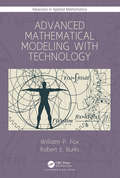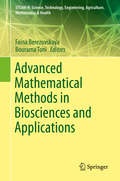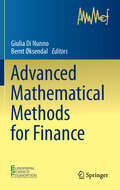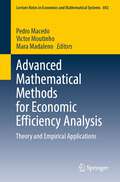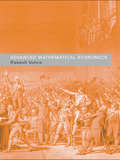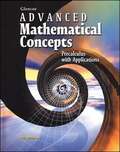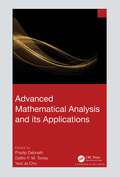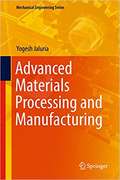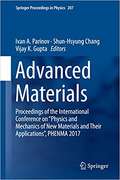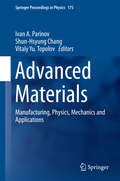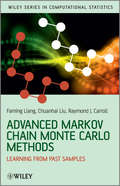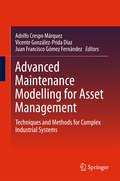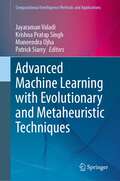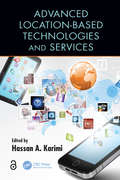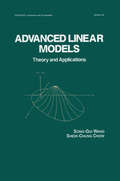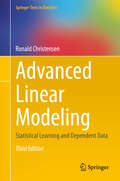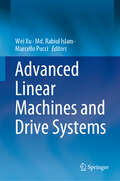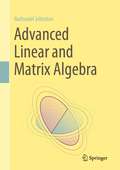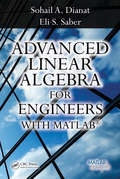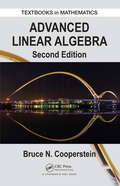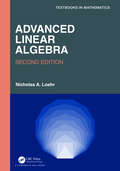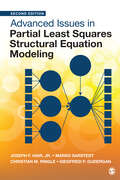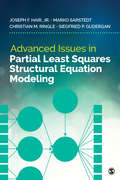- Table View
- List View
Advanced Mathematical Modeling with Technology (Advances in Applied Mathematics)
by William P. Fox Robert E. BurksMathematical modeling is both a skill and an art and must be practiced in order to maintain and enhance the ability to use those skills. Though the topics covered in this book are the typical topics of most mathematical modeling courses, this book is best used for individuals or groups who have already taken an introductory mathematical modeling course. Advanced Mathematical Modeling with Technology will be of interest to instructors and students offering courses focused on discrete modeling or modeling for decision making. Each chapter begins with a problem to motivate the reader. The problem tells "what" the issue is or problem that needs to be solved. In each chapter, the authors apply the principles of mathematical modeling to that problem and present the steps in obtaining a model. The key focus is the mathematical model and the technology is presented as a method to solve that model or perform sensitivity analysis. We have selected , where applicable to the content because of their wide accessibility. The authors utilize technology to build, compute, or implement the model and then analyze the it. Features: MAPLE©, Excel©, and R© to support the mathematical modeling process. Excel templates, macros, and programs are available upon request from authors. Maple templates and example solution are also available. Includes coverage of mathematical programming. The power and limitations of simulations is covered. Introduces multi-attribute decision making (MADM) and game theory for solving problems. The book provides an overview to the decision maker of the wide range of applications of quantitative approaches to aid in the decision making process, and present a framework for decision making. Table of Contents 1. Perfect Partners: Mathematical Modeling and Technology 2. Review of Modeling with Discrete Dynamical Systems and Modeling Systems of DDS 3. Modeling with Differential Equations 4. Modeling System of Ordinary Differential Equation 5. Regression and Advanced Regression Methods and Models 6. Linear, Integer and Mixed Integer Programming 7. Nonlinear Optimization Methods 8. Multivariable Optimization 9. Simulation Models 10. Modeling Decision Making with Multi-Attribute Decision Modeling with Technology 11. Modeling with Game Theory 12. Appendix Using R Index Biographies Dr. William P. Fox is currently a visiting professor of Computational Operations Research at the College of William and Mary. He is an emeritus professor in the Department of Defense Analysis at the Naval Postgraduate School and teaches a three-course sequence in mathematical modeling for decision making. He received his Ph.D. in Industrial Engineering from Clemson University. He has taught at the United States Military Academy for twelve years until retiring and at Francis Marion University where he was the chair of mathematics for eight years. He has many publications and scholarly activities including twenty plus books and one hundred and fifty journal articles. Colonel (R) Robert E. Burks, Jr., Ph.D. is an Associate Professor in the Defense Analysis Department of the Naval Postgraduate School (NPS) and the Director of the NPS’ Wargaming Center. He holds a Ph.D. in Operations Research form the Air Force Institute of Technology. He is a retired logistics Army Colonel with more than thirty years of military experience in leadership, advanced analytics, decision modeling, and logistics operations who served as an Army Operations Research analyst at the Naval Postgraduate School, TRADOC Analysis
Advanced Mathematical Methods in Biosciences and Applications (STEAM-H: Science, Technology, Engineering, Agriculture, Mathematics & Health)
by Bourama Toni Faina BerezovskayaFeaturing contributions from experts in mathematical biology and biomedical research, this edited volume covers a diverse set of topics on mathematical methods and applications in the biosciences. Topics focus on advanced mathematical methods, with chapters on the mathematical analysis of the quasispecies model, Arnold’s weak resonance equation, bifurcation analysis, and the Tonnelier-Gerstner model. Special emphasis is placed on applications such as natural selection, population heterogeneity, polyvariant ontogeny in plants, cancer dynamics, and analytical solutions for traveling pulses and wave trains in neural models. A survey on quasiperiodic topology is also presented in this book. Carefully peer-reviewed, this volume is suitable for students interested in interdisciplinary research. Researchers in applied mathematics and the biosciences will find this book an important resource on the latest developments in the field. In keeping with the STEAM-H series, the editors hope to inspire interdisciplinary understanding and collaboration.
Advanced Mathematical Methods for Finance
by Giulia Di Nunno Bernt ØksendalThis book presents innovations in the mathematical foundations of financial analysis and numerical methods for finance and applications to the modeling of risk. The topics selected include measures of risk, credit contagion, insider trading, information in finance, stochastic control and its applications to portfolio choices and liquidation, models of liquidity, pricing, and hedging. The models presented are based on the use of Brownian motion, Lévy processes and jump diffusions. Moreover, fractional Brownian motion and ambit processes are also introduced at various levels. The chosen blend of topics gives an overview of the frontiers of mathematics for finance. New results, new methods and new models are all introduced in different forms according to the subject. Additionally, the existing literature on the topic is reviewed. The diversity of the topics makes the book suitable for graduate students, researchers and practitioners in the areas of financial modeling and quantitative finance. The chapters will also be of interest to experts in the financial market interested in new methods and products. This volume presents the results of the European ESF research networking program Advanced Mathematical Methods for Finance.
Advanced Mathematical Methods for Economic Efficiency Analysis: Theory and Empirical Applications (Lecture Notes in Economics and Mathematical Systems #692)
by Pedro Macedo Victor Moutinho Mara MadalenoEconomic efficiency analysis has received considerable worldwide attention in the last few decades, with Stochastic Frontier Analysis (SFA) and Data Envelopment Analysis (DEA) establishing themselves as the two dominant approaches in the literature. This book, by combining cutting-edge theoretical research on DEA and SFA with attractive real-world applications, offers a valuable asset for professors, students, researchers, and professionals working in all branches of economic efficiency analysis, as well as those concerned with the corresponding economic policies. The book is divided into three parts, the first of which is devoted to basic concepts, making the content self-contained. The second is devoted to DEA, and the third to SFA. The topics covered in Part 2 range from stochastic DEA to multidirectional dynamic inefficiency analysis, including directional distance functions, the elimination and choice translating algorithm, benefit-of-the-doubt composite indicators, and internal benchmarking for efficiency evaluations. Part 3 also includes exciting and cutting-edge theoretical research on e.g. robustness, nonparametric stochastic frontier models, hierarchical panel data models, and estimation methods like corrected ordinary least squares and maximum entropy.
Advanced Mathematical Economics (Routledge Advanced Texts in Economics and Finance)
by Rakesh V. VohraThis concise textbook presents students with all they need for advancing in mathematical economics. Detailed yet student-friendly, Vohra's book contains chapters in, amongst others: * Feasibility * Convex Sets * Linear and Non-linear Programming* Lattices and Supermodularity. Higher level undergraduates as well as postgraduate students in mathematical economics will find this book extremely useful in their development as economists.
Advanced Mathematical Concepts: Precalculus with Applications
by Berchie Holliday Gilbert J. Cuevas Melissa S. Mcclure John A. Carter Daniel MarksLearn about relations, functions, graphs, trigonometry, discrete mathematics and calculus in this book.
Advanced Mathematical Concepts: Precalculus with Applications
by Glencoe StaffPrecalculus textbook, covering topics from graphing, to trigonometry, to conic sections, to the surface of calculus
Advanced Mathematical Analysis and its Applications
by Pradip Debnath Delfim F. M. Torres Yeol Je ChoAdvanced Mathematical Analysis and its Applications presents state-of-the-art developments in mathematical analysis through new and original contributions and surveys, with a particular emphasis on applications in engineering and mathematical sciences. New research directions are indicated in each of the chapters, and while this book is meant primarily for graduate students, there is content that will be equally useful and stimulating for faculty and researchers. The readers of this book will require minimum knowledge of real, complex, and functional analysis, and topology. Features Suitable as a reference for graduate students, researchers, and faculty Contains the most up-to-date developments at the time of writing.
Advanced Materials Processing and Manufacturing (Mechanical Engineering)
by Yogesh JaluriaFocuses on new and advanced methods of manufacturing and materials processing with traditional methods described in light of the new approaches.<P><P> Maximizes reader understanding of the fundamentals of how materials change, what transport processes are involved, and how these can be simulated and optimized - concepts not covered elsewhere.<P> Introduces new materials and applications in manufacturing and summarizes traditional processing methods, such as heat treatment, extrusion, casting, injection molding, and bonding, to show how they have evolved and how they could be used for meeting the challenges that we face today<P>This book focuses on advanced processing of new and emerging materials, and advanced manufacturing systems based on thermal transport and fluid flow. It examines recent areas of considerable growth in new and emerging manufacturing techniques and materials, such as fiber optics, manufacture of electronic components, polymeric and composite materials, alloys, microscale components, and new devices and applications. The book includes analysis, mathematical modeling, numerical simulation and experimental study of processes for prediction, design and optimization. It discusses the link between the characteristics of the final product and the basic transport mechanisms and provides a foundation for the study of a wide range of manufacturing processes.
Advanced Materials: Proceedings Of The International Conference On Physics And Mechanics Of New Materials And Their Applications , PHENMA 2017 (Springer Proceedings In Physics #207)
by Shun-Hsyung Chang Ivan A. Parinov Vijay K. GuptaProvides a consistent and original presentation of fabrication techniques, physics, mechanics, and applications of advanced materials and composites.<p><p> Helps readers to better understand modern R&D requirements for prospective materials and composites.<p> Features original theoretical, experimental and modeling results on novel materials and devices.<p> This book presents selected peer-reviewed contributions from the 2017 International Conference on “Physics and Mechanics of New Materials and Their Applications”, PHENMA 2017 (Jabalpur, India, 14–16 October, 2017), which is devoted to processing techniques, physics, mechanics, and applications of advanced materials. The book focuses on a wide spectrum of nanostructures, ferroelectric crystals, materials and composites as well as promising materials with special properties. It presents nanotechnology approaches, modern environmentally friendly piezoelectric and ferromagnetic techniques and physical and mechanical studies of the structural and physical–mechanical properties of materials. Various original mathematical and numerical methods are applied to the solution of different technological, mechanical and physical problems that are interesting from theoretical, modeling and experimental points of view. Further, the book highlights novel devices with high accuracy, longevity and extended capabilities to operate under wide temperature and pressure ranges and aggressive media, which show improved characteristics, thanks to the developed materials and composites, opening new possibilities for different physico-mechanical processes and phenomena
Advanced Materials: Manufacturing, Physics, Mechanics and Applications (Springer Proceedings in Physics #175)
by Vitaly Yu. Topolov Shun-Hsyung Chang Ivan A. ParinovAdvanced materials are the basis of modern science and technology. This proceedings volume presents a broad spectrum of studies of novel materials covering their processing techniques, physics, mechanics, and applications. The book is concentrated on nanostructures, ferroelectric crystals, materials and composites, materials for solar cells and also polymeric composites. Nanotechnology approaches, modern piezoelectric techniques and also latest achievements in materials science, condensed matter physics, mechanics of deformable solids and numerical methods are presented. Great attention is devoted to novel devices with high accuracy, longevity and extended possibilities to work in wide temperature and pressure ranges, aggressive media etc. The characteristics of materials and composites with improved properties opening new possibilities of various physical processes, in particular transmission and receipt of signals under water, are described.
Advanced Markov Chain Monte Carlo Methods
by Faming Liang Raymond Carroll Chuanhai LiuMarkov Chain Monte Carlo (MCMC) methods are now an indispensable tool in scientific computing. This book discusses recent developments of MCMC methods with an emphasis on those making use of past sample information during simulations. The application examples are drawn from diverse fields such as bioinformatics, machine learning, social science, combinatorial optimization, and computational physics.Key Features:Expanded coverage of the stochastic approximation Monte Carlo and dynamic weighting algorithms that are essentially immune to local trap problems.A detailed discussion of the Monte Carlo Metropolis-Hastings algorithm that can be used for sampling from distributions with intractable normalizing constants.Up-to-date accounts of recent developments of the Gibbs sampler.Comprehensive overviews of the population-based MCMC algorithms and the MCMC algorithms with adaptive proposals.This book can be used as a textbook or a reference book for a one-semester graduate course in statistics, computational biology, engineering, and computer sciences. Applied or theoretical researchers will also find this book beneficial.
Advanced Maintenance Modelling for Asset Management: Techniques and Methods for Complex Industrial Systems
by Adolfo Crespo Márquez Vicente González-Prida Díaz Juan Francisco Gómez FernándezThis book promotes and describes the application of objective and effective decision making in asset management based on mathematical models and practical techniques that can be easily implemented in organizations. This comprehensive and timely publication will be an essential reference source, building on available literature in the field of asset management while laying the groundwork for further research breakthroughs in this field. The text provides the resources necessary for managers, technology developers, scientists and engineers to adopt and implement better decision making based on models and techniques that contribute to recognizing risks and uncertainties and, in general terms, to the important role of asset management to increase competitiveness in organizations.
Advanced Machine Learning with Evolutionary and Metaheuristic Techniques (Computational Intelligence Methods and Applications)
by Jayaraman Valadi Krishna Pratap Singh Muneendra Ojha Patrick SiarryThis book delves into practical implementation of evolutionary and metaheuristic algorithms to advance the capacity of machine learning. The readers can gain insight into the capabilities of data-driven evolutionary optimization in materials mechanics, and optimize your learning algorithms for maximum efficiency. Or unlock the strategies behind hyperparameter optimization to enhance your transfer learning algorithms, yielding remarkable outcomes. Or embark on an illuminating journey through evolutionary techniques designed for constructing deep-learning frameworks. The book also introduces an intelligent RPL attack detection system tailored for IoT networks. Explore a promising avenue of optimization by fusing Particle Swarm Optimization with Reinforcement Learning. It uncovers the indispensable role of metaheuristics in supervised machine learning algorithms. Ultimately, this book bridges the realms of evolutionary dynamic optimization andmachine learning, paving the way for pioneering innovations in the field.
Advanced Location-Based Technologies and Services
by Hassan A. KarimiSince the publication of the first edition in 2004, advances in mobile devices, positioning sensors, WiFi fingerprinting, and wireless communications, among others, have paved the way for developing new and advanced location-based services (LBSs). This second edition provides up-to-date information on LBSs, including WiFi fingerprinting, mobile computing, geospatial clouds, geospatial data mining, location privacy, and location-based social networking. It also includes new chapters on application areas such as LBSs for public health, indoor navigation, and advertising. In addition, the chapter on remote sensing has been revised to address advancements.
Advanced Linear Models: Theory and Applications (Statistics: Textbooks and Monographs #141)
by Shein-Chung Chow Song-Gui WangThis work details the statistical inference of linear models including parameter estimation, hypothesis testing, confidence intervals, and prediction. The authors discuss the application of statistical theories and methodologies to various linear models such as the linear regression model, the analysis of variance model, the analysis of covariance model, and the variance components model.
Advanced Linear Modeling: Statistical Learning and Dependent Data (Springer Texts in Statistics)
by Ronald ChristensenThis book introduces several topics related to linear model theory, including: multivariate linear models, discriminant analysis, principal components, factor analysis, time series in both the frequency and time domains, and spatial data analysis. This second edition adds new material on nonparametric regression, response surface maximization, and longitudinal models. The book provides a unified approach to these disparate subjects and serves as a self-contained companion volume to the author's Plane Answers to Complex Questions: The Theory of Linear Models. Ronald Christensen is Professor of Statistics at the University of New Mexico. He is well known for his work on the theory and application of linear models having linear structure.
Advanced Linear Machines and Drive Systems
by Wei Xu Md. Rabiul Islam Marcello PucciThis book collects the latest theoretical and technological concepts in the design and control of various linear machines and drive systems. Discussing advances in the new linear machine topologies, integrated modeling, multi-objective optimization techniques, and high-performance control strategies, it focuses on emerging applications of linear machines in transportation and energy systems. The book presents both theoretical and practical/experimental results, providing a consistent compilation of fundamental theories, a compendium of current research and development activities as well as new directions to overcome critical limitations.
Advanced Linear and Matrix Algebra
by Nathaniel JohnstonThis textbook emphasizes the interplay between algebra and geometry to motivate the study of advanced linear algebra techniques. Matrices and linear transformations are presented as two sides of the same coin, with their connection motivating inquiry throughout the book. Building on a first course in linear algebra, this book offers readers a deeper understanding of abstract structures, matrix decompositions, multilinearity, and tensors. Concepts draw on concrete examples throughout, offering accessible pathways to advanced techniques. Beginning with a study of vector spaces that includes coordinates, isomorphisms, orthogonality, and projections, the book goes on to focus on matrix decompositions. Numerous decompositions are explored, including the Shur, spectral, singular value, and Jordan decompositions. In each case, the author ties the new technique back to familiar ones, to create a coherent set of tools. Tensors and multilinearity complete the book, with a study of the Kronecker product, multilinear transformations, and tensor products. Throughout, “Extra Topic” sections augment the core content with a wide range of ideas and applications, from the QR and Cholesky decompositions, to matrix-valued linear maps and semidefinite programming. Exercises of all levels accompany each section. Advanced Linear and Matrix Algebra offers students of mathematics, data analysis, and beyond the essential tools and concepts needed for further study. The engaging color presentation and frequent marginal notes showcase the author’s visual approach. A first course in proof-based linear algebra is assumed. An ideal preparation can be found in the author’s companion volume, Introduction to Linear and Matrix Algebra.
Advanced Linear Algebra for Engineers with MATLAB
by Sohail A. Dianat Eli SaberArming readers with both theoretical and practical knowledge, Advanced Linear Algebra for Engineers with MATLAB® provides real-life problems that readers can use to model and solve engineering and scientific problems in fields ranging from signal processing and communications to electromagnetics and social and health sciences. Facilitating a unique understanding of rapidly evolving linear algebra and matrix methods, this book: Outlines the basic concepts and definitions behind matrices, matrix algebra, elementary matrix operations, and matrix partitions, describing their potential use in signal and image processing applications Introduces concepts of determinants, inverses, and their use in solving linear equations that result from electrical and mechanical-type systems Presents special matrices, linear vector spaces, and fundamental principles of orthogonality, using an appropriate blend of abstract and concrete examples and then discussing associated applications to enhance readers’ visualization of presented concepts Discusses linear operators, eigenvalues, and eigenvectors, and explores their use in matrix diagonalization and singular value decomposition Extends presented concepts to define matrix polynomials and compute functions using several well-known methods, such as Sylvester’s expansion and Cayley-Hamilton Introduces state space analysis and modeling techniques for discrete and continuous linear systems, and explores applications in control and electromechanical systems, to provide a complete solution for the state space equation Shows readers how to solve engineering problems using least square, weighted least square, and total least square techniques Offers a rich selection of exercises and MATLAB® assignments that build a platform to enhance readers’ understanding of the material Striking the appropriate balance between theory and real-life applications, this book provides both advanced students and professionals in the field with a valuable reference that they will continually consult.
Advanced Linear Algebra (Textbooks in Mathematics)
by Bruce CoopersteinThis book discusses structure theory of an operator, topics on inner product spaces, and trace and determinant functions of a linear operator. It addresses bilinear forms with a full treatment of symplectic spaces and orthogonal spaces, as well as explains construction of tensor, symmetric, and exterior algebras. Featuring several new exercises, the second edition adds coverage of sesquilinear forms, linear groups, matrices, normed vector spaces, orthogonal spaces over perfect fields of characteristic two, and Clifford algebras. A solutions manual is available upon qualifying course adoption.
Advanced Linear Algebra (Textbooks in Mathematics)
by Nicholas A. LoehrDesigned for advanced undergraduate and beginning graduate students in linear or abstract algebra, Advanced Linear Algebra covers theoretical aspects of the subject, along with examples, computations, and proofs. It explores a variety of advanced topics in linear algebra that highlight the rich interconnections of the subject to geometry, algebra, analysis, combinatorics, numerical computation, and many other areas of mathematics.The author begins with chapters introducing basic notation for vector spaces, permutations, polynomials, and other algebraic structures. The following chapters are designed to be mostly independent of each other so that readers with different interests can jump directly to the topic they want. This is an unusual organization compared to many abstract algebra textbooks, which require readers to follow the order of chapters.Each chapter consists of a mathematical vignette devoted to the development of one specific topic. Some chapters look at introductory material from a sophisticated or abstract viewpoint, while others provide elementary expositions of more theoretical concepts. Several chapters offer unusual perspectives or novel treatments of standard results.A wide array of topics is included, ranging from concrete matrix theory (basic matrix computations, determinants, normal matrices, canonical forms, matrix factorizations, and numerical algorithms) to more abstract linear algebra (modules, Hilbert spaces, dual vector spaces, bilinear forms, principal ideal domains, universal mapping properties, and multilinear algebra).The book provides a bridge from elementary computational linear algebra to more advanced, abstract aspects of linear algebra needed in many areas of pure and applied mathematics.
Advanced Issues in Partial Least Squares Structural Equation Modeling
by Joe Hair Marko Sarstedt Christian M. Ringle Siegfried P. GuderganThe Second Edition of Advanced Issues in Partial Least Squares Structural Equation Modeling offers a straightforward and practical guide to PLS-SEM for users ready to go further than the basics of A Primer on Partial Least Squares Structural Equation Modeling, Third Edition. Even in this advanced guide, the authors have limited the emphasis on equations, formulas, and Greek symbols, and instead rely on detailed explanations of the fundamentals of PLS-SEM and provide general guidelines for understanding and evaluating the results of applying the method. A single study on corporate reputation features as an example throughout the book, along with a single software package (SmartPLS 4.0) to provide a seamless learning experience. The approach of this book is based on the authors’ many years of conducting research and teaching methodology courses, including developing the SmartPLS software. The preparation of the book, especially this new edition, is based on the authors’ desire to communicate the PLS-SEM method to a much broader audience from management and marketing to engineering, geography, medicine, political and environmental sciences, psychology, and beyond. The Second Edition includes a new chapter on the necessary condition analysis (NCA) and covers the most recent developments in PLS-SEM, with detailed guidelines for estimating and validating higher-order constructs and nonlinear effects as well as more insights on multigroup and latent class analyses using FIMIX-PLS and PLS-POS. The book is aimed at researchers and practitioners who seek to gain comprehensive knowledge of more advanced PLS-SEM methods.
Advanced Issues in Partial Least Squares Structural Equation Modeling
by Joe Hair Marko Sarstedt Christian M. Ringle Siegfried P. GuderganThe Second Edition of Advanced Issues in Partial Least Squares Structural Equation Modeling offers a straightforward and practical guide to PLS-SEM for users ready to go further than the basics of A Primer on Partial Least Squares Structural Equation Modeling, Third Edition. Even in this advanced guide, the authors have limited the emphasis on equations, formulas, and Greek symbols, and instead rely on detailed explanations of the fundamentals of PLS-SEM and provide general guidelines for understanding and evaluating the results of applying the method. A single study on corporate reputation features as an example throughout the book, along with a single software package (SmartPLS 4.0) to provide a seamless learning experience. The approach of this book is based on the authors’ many years of conducting research and teaching methodology courses, including developing the SmartPLS software. The preparation of the book, especially this new edition, is based on the authors’ desire to communicate the PLS-SEM method to a much broader audience from management and marketing to engineering, geography, medicine, political and environmental sciences, psychology, and beyond. The Second Edition includes a new chapter on the necessary condition analysis (NCA) and covers the most recent developments in PLS-SEM, with detailed guidelines for estimating and validating higher-order constructs and nonlinear effects as well as more insights on multigroup and latent class analyses using FIMIX-PLS and PLS-POS. The book is aimed at researchers and practitioners who seek to gain comprehensive knowledge of more advanced PLS-SEM methods.
Advanced Issues in Partial Least Squares Structural Equation Modeling
by Marko Sarstedt Dr Joe Hair Dr Christian M. Ringle Dr Siegfried P. GuderganWritten as an extension of A Primer on Partial Least Squares Structural Equation Modeling (PLS-SEM) Second Edition, this easy-to-understand, practical guide covers advanced content on PLS-SEM to help students and researchers apply techniques to research problems and accurately interpret results. Authors Joseph F. Hair, Jr., Marko Sarstedt, Christian Ringle, and Siegfried P. Gudergan provide a brief overview of basic concepts before moving to the more advanced material. Offering extensive examples on SmartPLS 3 software and accompanied by free downloadable data sets, the book emphasizes that any advanced PLS-SEM approach should be carefully applied to ensure that it fits the appropriate research context and the data characteristics that underpin the research.
